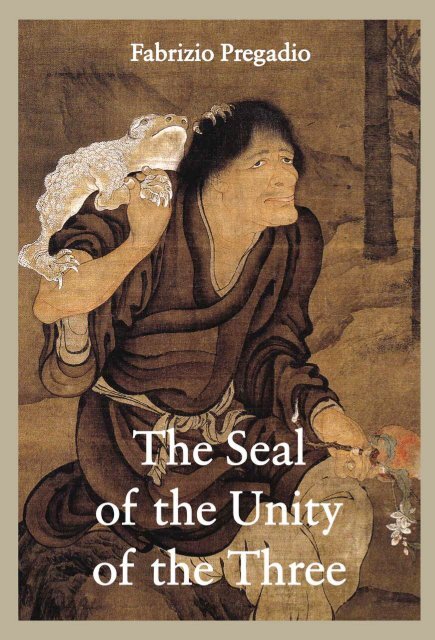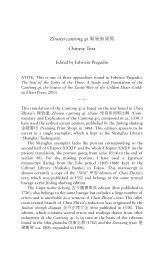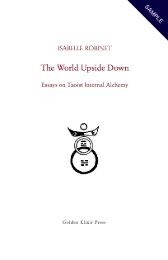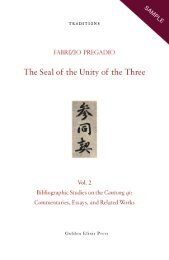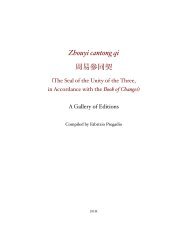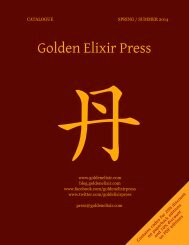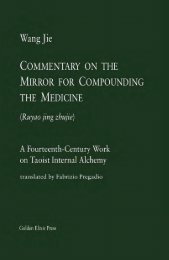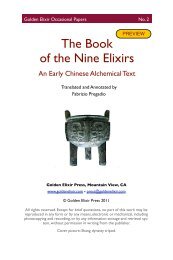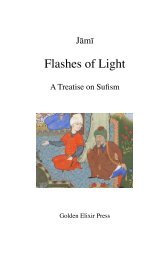The Seal of the Unity of the Three - The Golden Elixir
The Seal of the Unity of the Three - The Golden Elixir
The Seal of the Unity of the Three - The Golden Elixir
You also want an ePaper? Increase the reach of your titles
YUMPU automatically turns print PDFs into web optimized ePapers that Google loves.
Fabrizio Pregadio<br />
<strong>The</strong> <strong>Seal</strong> <strong>of</strong> <strong>the</strong> <strong>Unity</strong> <strong>of</strong> <strong>the</strong> <strong>Three</strong><br />
A Study and Translation <strong>of</strong> <strong>the</strong> Cantong qi,<br />
<strong>the</strong> Source <strong>of</strong> <strong>the</strong> Taoist Way <strong>of</strong> <strong>the</strong> <strong>Golden</strong> <strong>Elixir</strong><br />
<strong>Golden</strong> <strong>Elixir</strong> Press
This sample contains translations <strong>of</strong> 9 <strong>of</strong> <strong>the</strong> 88 sections<br />
<strong>of</strong> <strong>the</strong> Cantong qi. <strong>The</strong> general introduction and o<strong>the</strong>r parts <strong>of</strong><br />
<strong>the</strong> book are omitted. For more information and o<strong>the</strong>r samples<br />
visit this web page:<br />
www.goldenelixir.com/press/trl_02_ctq.html<br />
© 2011 Fabrizio Pregadio<br />
ISBN 978-09843082-8-6 (pbk)<br />
<strong>Golden</strong> <strong>Elixir</strong> Press, Mountain View, CA<br />
www.goldenelixir.com<br />
press@goldenelixir.com<br />
All rights reserved. Except for brief quotations, no part <strong>of</strong> this book<br />
may be reproduced in any form or by any means,<br />
electronic or mechanical, including photocopying and recording,<br />
or by any information storage and retrieval system,<br />
without permission in writing from <strong>the</strong> publisher.<br />
Typeset in Sabon. Text area proportioned in <strong>the</strong> <strong>Golden</strong> Section.<br />
Cover: <strong>The</strong> Chinese character dan , “<strong>Elixir</strong>.”
Translation
1 Qian and Kun, Kan and Li<br />
1–6 “Qian and Kun are <strong>the</strong> door and <strong>the</strong> gate <strong>of</strong> change,”<br />
<strong>the</strong> fa<strong>the</strong>r and <strong>the</strong> mo<strong>the</strong>r <strong>of</strong> all hexagrams.<br />
Kan and Li are <strong>the</strong> inner and <strong>the</strong> outer walls,<br />
<strong>the</strong>y spin <strong>the</strong> hub and align <strong>the</strong> axle.<br />
Female and male, <strong>the</strong>se four trigrams<br />
function as a bellows and its nozzles.<br />
7 Sun and Moon make change<br />
1–4 Wu in Kan is <strong>the</strong> essence <strong>of</strong> <strong>the</strong> Moon,<br />
ji in Li is <strong>the</strong> radiance <strong>of</strong> <strong>the</strong> Sun.<br />
Sun and Moon make change,<br />
<strong>the</strong> firm and <strong>the</strong> yielding match one ano<strong>the</strong>r.<br />
5–10 Soil rules over <strong>the</strong> four seasons,<br />
entwining beginning and end;<br />
green, red, black, and white<br />
each dwells in one direction.<br />
All are endowed by <strong>the</strong> Central Palace<br />
through <strong>the</strong> efficacy <strong>of</strong> wu and ji.<br />
10 <strong>The</strong> joining <strong>of</strong> <strong>the</strong> Sun and <strong>the</strong> Moon<br />
1–5 Between <strong>the</strong> month’s last day and dawn on next month’s<br />
first day, Zhen comes to receive <strong>the</strong> tally. At that moment,<br />
Heaven and Earth merge <strong>the</strong>ir essences, and <strong>the</strong> Sun<br />
and <strong>the</strong> Moon reach out for one ano<strong>the</strong>r and hold onto<br />
one ano<strong>the</strong>r.<br />
www.goldenelixir.com/press/trl_02_ctq.html
6 Translation<br />
—————————————————————————————————————————<br />
6–9 <strong>The</strong> masculine Yang spreads his mysterious emanation,<br />
<strong>the</strong> feminine Yin transforms her yellow wrap.<br />
In indistinction <strong>the</strong>y conjoin;<br />
at this incipient time, <strong>the</strong> root is planted.<br />
10–13 Steadily and orderly <strong>the</strong> seed is nourished;<br />
from <strong>the</strong> coagulation <strong>of</strong> Spirit <strong>the</strong> corporeal frame is<br />
formed.<br />
This is how living beings come forth:<br />
even <strong>the</strong> wriggling worms all proceed from this.<br />
18 Nourishing inner nature<br />
1–4 Innerly nourish yourself,<br />
serene and quiescent in Empty Non-Being.<br />
Going back to <strong>the</strong> fundament conceal your light,<br />
and innerly illuminate your body.<br />
5–8 “Shut <strong>the</strong> openings”<br />
and raise and streng<strong>the</strong>n <strong>the</strong> Numinous Trunk;<br />
as <strong>the</strong> three luminaries sink into <strong>the</strong> ground,<br />
warmly nourish <strong>the</strong> Pearl.<br />
9–10 “Watching, you do not see it” —<br />
it is nearby and easy to seek.<br />
22 <strong>The</strong> principles <strong>of</strong> alchemy<br />
1–2 “Know <strong>the</strong> white, keep to <strong>the</strong> black,”<br />
and <strong>the</strong> Numinous Light will come <strong>of</strong> its own.<br />
3–6 White is <strong>the</strong> essence <strong>of</strong> Metal,<br />
Black <strong>the</strong> foundation <strong>of</strong> Water.<br />
Water is <strong>the</strong> axis <strong>of</strong> <strong>the</strong> Dao:<br />
its number is 1.<br />
www.goldenelixir.com/press/trl_02_ctq.html
Translation 7<br />
—————————————————————————————————————————<br />
7–10 At <strong>the</strong> beginning <strong>of</strong> Yin and Yang,<br />
Mystery holds <strong>the</strong> Yellow Sprout;<br />
it is <strong>the</strong> ruler <strong>of</strong> <strong>the</strong> five metals,<br />
<strong>the</strong> River Chariot <strong>of</strong> <strong>the</strong> nor<strong>the</strong>rn direction.<br />
11–14 That is why lead is black on <strong>the</strong> outside<br />
but cherishes <strong>the</strong> <strong>Golden</strong> Flower within,<br />
like <strong>the</strong> man who “wears rough-hewn clo<strong>the</strong>s but cherishes<br />
a piece <strong>of</strong> jade in his bosom,”<br />
and outwardly behaves like a fool.<br />
26 Incorrect practices<br />
1–8 This is not <strong>the</strong> method <strong>of</strong> passing through <strong>the</strong> viscera, <strong>of</strong><br />
inner contemplation and having a point <strong>of</strong> concentration;<br />
<strong>of</strong> treading <strong>the</strong> Dipper and pacing <strong>the</strong> asterisms, using <strong>the</strong><br />
six jia as markers <strong>of</strong> time;<br />
<strong>of</strong> sating yourself with <strong>the</strong> nine-and-one in <strong>the</strong> Way <strong>of</strong><br />
Yin, meddling and tampering with <strong>the</strong> original womb;<br />
<strong>of</strong> ingesting breath till it chirps in your stomach, exhaling<br />
<strong>the</strong> pure and inhaling <strong>the</strong> evil without.<br />
9–12 Day and night you go without slumber,<br />
month after month, you never take rest.<br />
From exhaustion your body daily grows weak:<br />
you may be “vague and indistinct,” but look like a fool.<br />
13–16 Your hundred vessels stir and see<strong>the</strong> like a cauldron,<br />
unable to settle and clear.<br />
Amassing soil you set up space for an altar,<br />
and at daybreak and sunset you worship in awe.<br />
17–20 Demonic creatures reveal <strong>the</strong>ir shapes,<br />
at whose sight in your dreams you sigh with emotion.<br />
www.goldenelixir.com/press/trl_02_ctq.html
8 Translation<br />
—————————————————————————————————————————<br />
Rejoiced in your heart, pleased in your thoughts,<br />
you tell yourself, surely, your life will grow long.<br />
21–24 But death, unexpected, comes ahead <strong>of</strong> its time,<br />
and you forsake your body to rot.<br />
Your deeds have rebounded,<br />
for you were defiant and let slip <strong>the</strong> hinge.<br />
25–30 <strong>The</strong> arts are so many —<br />
for each thousand, <strong>the</strong>re are ten thousand more.<br />
<strong>The</strong>ir tortuous routes run against <strong>the</strong> Yellow Emperor and<br />
<strong>the</strong> Old Master,<br />
<strong>the</strong>ir winding courses oppose <strong>the</strong> Nine Capitals.<br />
Those who are bright comprehend <strong>the</strong> meaning <strong>of</strong> this:<br />
in all its breadth <strong>the</strong>y know where it comes from.<br />
29 <strong>The</strong> “two eights”<br />
1–2 <strong>The</strong> waxing quarter is Dui , its number is 8;<br />
<strong>the</strong> waning quarter is Gen , it is also 8.<br />
3–6 <strong>The</strong> two quarters join <strong>the</strong>ir essences,<br />
forming <strong>the</strong> bodies <strong>of</strong> Qian and Kun .<br />
Two times 8 corresponds to one pound:<br />
<strong>the</strong> Way <strong>of</strong> <strong>the</strong> Changes is correct and unbiased.<br />
55 Water, <strong>the</strong> beginning<br />
1–4 “Qian is movement and is straight”:<br />
Breath spreads and Essence flows.<br />
“Kun is quiescence and is ga<strong>the</strong>red”:<br />
it is <strong>the</strong> hut <strong>of</strong> <strong>the</strong> Dao.<br />
5–8 <strong>The</strong> firm gives forth and <strong>the</strong>n recedes,<br />
<strong>the</strong> yielding transmutes and <strong>the</strong>reby nurtures.<br />
www.goldenelixir.com/press/trl_02_ctq.html
Translation 9<br />
—————————————————————————————————————————<br />
<strong>The</strong> 9 reverts, <strong>the</strong> 7 returns,<br />
<strong>the</strong> 8 goes back, <strong>the</strong> 6 remains.<br />
9–12 Man is white, woman is red;<br />
Metal and Fire seize one ano<strong>the</strong>r.<br />
Water <strong>the</strong>n stabilizes Fire:<br />
it is <strong>the</strong> first <strong>of</strong> <strong>the</strong> five agents.<br />
13–18 “Superior goodness is like water”<br />
because it is flawless and clear.<br />
<strong>The</strong>se are <strong>the</strong> forms and images <strong>of</strong> <strong>the</strong> Dao,<br />
but True <strong>Unity</strong> can hardly be charted:<br />
it alters itself and distributes by parting,<br />
and each part dwells alone, on its own.<br />
72 “<strong>The</strong> three things are one family”<br />
1–4 When <strong>the</strong> Wooden essence <strong>of</strong> cinnabar<br />
finds Metal, <strong>the</strong>y pair with each o<strong>the</strong>r:<br />
Metal and Water dwell in conjunction,<br />
Wood and Fire are companions.<br />
5–8 <strong>The</strong>se four, in indistinction,<br />
arrange <strong>the</strong>mselves as Dragon and Tiger:<br />
<strong>the</strong> Dragon is Yang, its number is odd,<br />
<strong>the</strong> Tiger is Yin, its number is even.<br />
9–12 <strong>The</strong> liver is green and is <strong>the</strong> fa<strong>the</strong>r,<br />
<strong>the</strong> lungs are white and are <strong>the</strong> mo<strong>the</strong>r,<br />
<strong>the</strong> kidneys are black and are <strong>the</strong> son,<br />
<strong>the</strong> heart is red and is <strong>the</strong> daughter.<br />
13–16 <strong>The</strong> spleen is yellow and is <strong>the</strong> forefa<strong>the</strong>r,<br />
and <strong>the</strong> son is at <strong>the</strong> origin <strong>of</strong> <strong>the</strong> five agents.<br />
<strong>The</strong> three things are one family:<br />
all <strong>of</strong> <strong>the</strong>m return to wu and ji.<br />
www.goldenelixir.com/press/trl_02_ctq.html
Notes
BOOK 1<br />
1. Qian and Kun, Kan and Li<br />
Sections 1–17 <strong>of</strong> Book 1 are devoted to cosmology. <strong>The</strong> constant<br />
conjunction <strong>of</strong> Qian and Kun, <strong>the</strong> active and <strong>the</strong> passive principles,<br />
gives birth to all phenomena in <strong>the</strong> world <strong>of</strong> change. <strong>The</strong>refore Qian<br />
and Kun are “<strong>the</strong> door and <strong>the</strong> gate” through which change arises,<br />
and “<strong>the</strong> fa<strong>the</strong>r and <strong>the</strong> mo<strong>the</strong>r” <strong>of</strong> all emblems that represent change.<br />
As <strong>the</strong>y join with one ano<strong>the</strong>r, Qian entrusts his generative potential<br />
to Kun and, in doing this, becomes Li ; Kun receives <strong>the</strong><br />
essence <strong>of</strong> Qian to bring it to fruition and, in doing this, becomes Kan<br />
. Since Kan and Li embrace Qian and Kun, represented by <strong>the</strong><br />
respective inner lines, <strong>the</strong>y provide “inner and outer walls” to Qian<br />
and Kun: <strong>the</strong> Yin principle () harbors True Yang (), and <strong>the</strong> Yang<br />
principle () harbors True Yin ().<br />
If <strong>the</strong> two sets <strong>of</strong> walls are shaped as joined semicircles, <strong>the</strong>y form<br />
a wheel (see fig. 3). <strong>The</strong> central hub is <strong>the</strong> emptiness from which<br />
existence comes forth; <strong>the</strong> axle passing through <strong>the</strong> hub is Qian and<br />
Kun, which hold <strong>the</strong> wheels in position; and <strong>the</strong> wheels with <strong>the</strong>ir<br />
spokes are <strong>the</strong> compass <strong>of</strong> space and <strong>the</strong> cycles <strong>of</strong> time governed by<br />
Kan and Li. <strong>The</strong> Daode jing (Book <strong>of</strong> <strong>the</strong> Way and its Virtue) uses <strong>the</strong><br />
same images to illustrate <strong>the</strong> operation (or “function,” yong) <strong>of</strong><br />
emptiness at <strong>the</strong> center <strong>of</strong> <strong>the</strong> cosmos: “Thirty spokes share one hub:<br />
wherein <strong>the</strong>re is nothing lies <strong>the</strong> function <strong>of</strong> a carriage. . . . <strong>The</strong>refore<br />
in what is <strong>the</strong>re lies <strong>the</strong> benefit; in what is not <strong>the</strong>re lies <strong>the</strong><br />
function” (Daode jing, 11).<br />
Qian, Kun, Kan, and Li are also compared to a bellows and its<br />
nozzles. <strong>The</strong> bellows (Qian and Kun) is empty, but sends forth its<br />
breath through <strong>the</strong> nozzles (Kan and Li). This image too alludes to a<br />
passage in <strong>the</strong> Daode jing, which refers to <strong>the</strong> empty center that brings<br />
about existence by saying: “<strong>The</strong> space between Heaven and Earth —<br />
is it not like a bellows? As empty, it is never exhausted; as it moves, it<br />
continues to pour” (Daode jing, 5).
14 Notes<br />
—————————————————————————————————————————<br />
Changes: “Qian and Kun are indeed <strong>the</strong> door and <strong>the</strong> gate <strong>of</strong><br />
change!” (B.5; see Wilhelm, 343).<br />
2. <strong>The</strong> fa<strong>the</strong>r and <strong>the</strong> mo<strong>the</strong>r <strong>of</strong> all hexagrams. Compare Book <strong>of</strong><br />
Changes, “Explanation <strong>of</strong> <strong>the</strong> Trigrams”: “Qian is Heaven, <strong>the</strong>refore he is<br />
called <strong>the</strong> fa<strong>the</strong>r. Kun is Earth, <strong>the</strong>refore she is called <strong>the</strong> mo<strong>the</strong>r” (sec. 9;<br />
see Wilhelm, 274). See also <strong>the</strong> “Commentary on <strong>the</strong> Judgement” on <strong>the</strong><br />
hexagrams Qian (no. 1) and Kun (no. 2): “Great indeed is Qian, <strong>the</strong><br />
Origin! <strong>The</strong> ten thousand things owe <strong>the</strong>ir beginning to him . . . Perfect<br />
indeed is Kun, <strong>the</strong> Origin! <strong>The</strong> ten thousand things owe <strong>the</strong>ir birth to<br />
her” (see Wilhelm, 370 and 386).<br />
3. Kan and Li are <strong>the</strong> inner and <strong>the</strong> outer walls. In <strong>the</strong> trigrams Kan <br />
and Li , <strong>the</strong> lower lines are <strong>the</strong> “inner wall,” and <strong>the</strong> upper lines are <strong>the</strong><br />
“outer wall.” <strong>The</strong> central lines respectively belong to Qian and Kun .<br />
7. Sun and Moon make change<br />
<strong>The</strong> Moon is Kan and <strong>the</strong> Sun is Li . However, although <strong>the</strong> Yin<br />
trigram Kan is associated with <strong>the</strong> Moon, it encloses a solid Yang line<br />
that belongs to Qian . This line corresponds to <strong>the</strong> celestial stem wu<br />
, an emblem <strong>of</strong> <strong>the</strong> active, creative aspect <strong>of</strong> <strong>the</strong> One. Analogously,<br />
<strong>the</strong> Yang trigram Li is associated with <strong>the</strong> Sun, but encloses a broken<br />
Yin line that belongs to Kun . This line corresponds to <strong>the</strong> celestial<br />
stem ji , representing <strong>the</strong> passive, fulfilling aspect <strong>of</strong> <strong>the</strong> One. When<br />
Qian and Kun are contained within Kan and Li, <strong>the</strong>y are called <strong>the</strong><br />
“essence” (jing) <strong>of</strong> <strong>the</strong> Moon and <strong>the</strong> “radiance” (guang) <strong>of</strong> <strong>the</strong> Sun.<br />
<strong>The</strong> alternation <strong>of</strong> <strong>the</strong> Sun and <strong>the</strong> Moon produces change. With<br />
regard to this, <strong>the</strong> Cantong qi observes that when <strong>the</strong> graphs that<br />
represent <strong>the</strong> Sun and <strong>the</strong> Moon are joined to one ano<strong>the</strong>r, with <strong>the</strong><br />
graph for “sun” (ri ) placed above <strong>the</strong> graph for “moon” (yue ),<br />
<strong>the</strong>y form <strong>the</strong> graph for “change” (yi ). This etymology <strong>of</strong> <strong>the</strong> word<br />
“change” does not pertain to philology, but is an example <strong>of</strong> <strong>the</strong><br />
analogical function <strong>of</strong> images and forms.<br />
In addition to being associated with True Yang (Qian) and True<br />
Yin (Kun), <strong>the</strong> celestial stems wu and ji are also emblems <strong>of</strong> <strong>the</strong><br />
central agent Soil, which, like <strong>the</strong> One, comprises Yin and Yang<br />
halves. Soil transmits <strong>the</strong> One Breath to <strong>the</strong> four directions and <strong>the</strong><br />
four seasons—i.e., to space and time—which correspond to <strong>the</strong> agents<br />
Wood, Fire, Water, and Metal, referred to here by <strong>the</strong> colors green,<br />
www.goldenelixir.com/press/trl_02_ctq.html
Notes 15<br />
—————————————————————————————————————————<br />
red, black, and white. In reiterating <strong>the</strong> unity <strong>of</strong> Qian and Kun, Kan<br />
and Li, and wu and ji, Soil guarantees <strong>the</strong> conjunction <strong>of</strong> <strong>the</strong> world <strong>of</strong><br />
multiplicity to <strong>the</strong> Absolute.<br />
10. <strong>The</strong> joining <strong>of</strong> <strong>the</strong> Sun and <strong>the</strong> Moon<br />
<strong>The</strong> joining <strong>of</strong> Kan and Li (Sun and Moon) occurs in <strong>the</strong> night<br />
between a month’s last day and next month’s first day; it replicates<br />
within space and time <strong>the</strong> joining <strong>of</strong> Qian and Kun (Heaven and<br />
Earth) in <strong>the</strong> precelestial domain. When Kan and Li join one ano<strong>the</strong>r,<br />
<strong>the</strong> active and <strong>the</strong> passive principles return to <strong>the</strong> original state <strong>of</strong><br />
indistinction. Qian endows Kun with its essence (which is<br />
“mysterious,” xuan, a word emblematic <strong>of</strong> Heaven), and <strong>the</strong> womb<br />
(“wrap”) <strong>of</strong> Kun (which is “yellow,” <strong>the</strong> color emblematic <strong>of</strong> Earth) is<br />
impregnated. Spirit produces that essence through its own coagulation<br />
(ning). Thus Kun receives <strong>the</strong> seed <strong>of</strong> Qian, and brings it to<br />
fruition. All forms <strong>of</strong> life are generated in this way.<br />
In <strong>the</strong> cosmos, <strong>the</strong> joining <strong>of</strong> <strong>the</strong> Sun and <strong>the</strong> Moon gives birth to<br />
a new time cycle, <strong>the</strong> lunar month. <strong>The</strong> first half <strong>of</strong> that cycle is ruled<br />
by <strong>the</strong> Yang principle, which flourishes until it culminates at <strong>the</strong><br />
middle <strong>of</strong> <strong>the</strong> month. <strong>The</strong> second half is ruled by <strong>the</strong> Yin principle,<br />
which similarly grows until it overcomes <strong>the</strong> Yang principle at <strong>the</strong> end<br />
<strong>of</strong> <strong>the</strong> month. <strong>The</strong>n <strong>the</strong> Sun and <strong>the</strong> Moon join once more, <strong>the</strong> Yang<br />
principle is reborn, and <strong>the</strong> cycle begins again.<br />
<strong>The</strong> trigram Zhen (Thunder) symbolizes <strong>the</strong> first stage <strong>of</strong> <strong>the</strong><br />
rebirth <strong>of</strong> luminous Yang after <strong>the</strong> obscurity <strong>of</strong> Yin. Its Yang line at<br />
<strong>the</strong> bottom (<strong>the</strong> position <strong>of</strong> <strong>the</strong> initial line) is an image <strong>of</strong> regeneration<br />
after stagnation, represented in <strong>the</strong> Book <strong>of</strong> Changes by <strong>the</strong> crack <strong>of</strong><br />
thunder produced by <strong>the</strong> conjunction <strong>of</strong> Yin and Yang. At <strong>the</strong> beginning<br />
<strong>of</strong> <strong>the</strong> month, Heaven assigns Zhen <strong>the</strong> task <strong>of</strong> ruling over <strong>the</strong><br />
first stage <strong>of</strong> <strong>the</strong> newly-born time cycle (<strong>the</strong> initial five days) and <strong>the</strong><br />
corresponding sector <strong>of</strong> space (East). Having been reborn, <strong>the</strong> Yang<br />
principle begins a new cycle <strong>of</strong> ascent and descent. Section 13 describes<br />
this cycle.<br />
4. Heaven and Earth merge <strong>the</strong>ir essences. Compare Book <strong>of</strong> Changes,<br />
“Appended Sayings”: “Heaven and Earth mesh toge<strong>the</strong>r, and <strong>the</strong> ten<br />
thousand things proliferate by transformation. Male and female join <strong>the</strong>ir<br />
www.goldenelixir.com/press/trl_02_ctq.html
16 Notes<br />
—————————————————————————————————————————<br />
essences, and <strong>the</strong> ten thousand things are born by transformation” (B.4;<br />
see Wilhelm, 342–43).<br />
18. Nourishing inner nature<br />
This is <strong>the</strong> first <strong>of</strong> ten sections (18–27) that illustrate <strong>the</strong> main features<br />
<strong>of</strong> “superior virtue” (shangde) and “inferior virtue” (xiade). <strong>The</strong><br />
import <strong>of</strong> <strong>the</strong>se chapters is made clear in sections 20–21: superior<br />
virtue is <strong>the</strong> way <strong>of</strong> non-doing (wuwei), and consists in <strong>the</strong> cultivation<br />
<strong>of</strong> inner nature (xing); inferior virtue is <strong>the</strong> way <strong>of</strong> doing (youwei),<br />
and focuses on <strong>the</strong> cultivation <strong>of</strong> one’s existence (or “vital force,”<br />
ming) by means <strong>of</strong> practices such as <strong>the</strong> alchemical ones.<br />
<strong>The</strong> subject <strong>of</strong> sections 18–19 is <strong>the</strong> principles <strong>of</strong> superior virtue.<br />
Emptiness is <strong>the</strong> fundament from which all things arise and to which<br />
<strong>the</strong>y return; quiescence is <strong>the</strong> state required to contemplate Emptiness.<br />
<strong>The</strong> first stanza expresses <strong>the</strong>se principles with allusions to an exemplary<br />
passage <strong>of</strong> <strong>the</strong> Daode jing: “Attain <strong>the</strong> ultimate <strong>of</strong> emptiness,<br />
guard <strong>the</strong> utmost <strong>of</strong> quiescence. <strong>The</strong> ten thousand things are brought<br />
about toge<strong>the</strong>r: accordingly, I observe <strong>the</strong>ir return. . . . Returning to<br />
<strong>the</strong> root means quiescence; being quiescent means reverting to one’s<br />
destiny; reverting to one’s destiny means being constant; knowing <strong>the</strong><br />
constant means being luminous” (Daode jing, 6). <strong>The</strong> subjects <strong>of</strong> <strong>the</strong><br />
present section <strong>of</strong> <strong>the</strong> Cantong qi are <strong>the</strong> same as those <strong>of</strong> this<br />
passage: Emptiness, <strong>the</strong> return to <strong>the</strong> root, and <strong>the</strong> luminous quality<br />
<strong>of</strong> those who achieve quiescence.<br />
Attaining <strong>the</strong> state <strong>of</strong> Emptiness requires closing <strong>the</strong> “openings”<br />
through which we deal with <strong>the</strong> world <strong>of</strong> multiplicity. This principle,<br />
and its formulation, also originate in <strong>the</strong> Daode jing: “Shut <strong>the</strong><br />
openings, close <strong>the</strong> gates, and to <strong>the</strong> end <strong>of</strong> your life you will not toil.<br />
Unlock <strong>the</strong> openings, meddle with affairs, and to <strong>the</strong> end <strong>of</strong> your life<br />
you will not attain salvation” (Daode jing, 52).<br />
For <strong>the</strong> Cantong qi, <strong>the</strong> openings are <strong>the</strong> “three luminaries”: <strong>the</strong><br />
eyes, <strong>the</strong> ears, and <strong>the</strong> mouth, or <strong>the</strong> functions <strong>of</strong> sight, hearing, and<br />
speech. When <strong>the</strong> “three luminaries” do not turn <strong>the</strong>ir light toward<br />
<strong>the</strong> external world, <strong>the</strong>y “sink into <strong>the</strong> ground.” This expression,<br />
which derives from <strong>the</strong> Zhuangzi, denotes <strong>the</strong> attitude <strong>of</strong> <strong>the</strong> saintly<br />
man who conceals his sainthood (see <strong>the</strong> note to verse 7). Established<br />
in quiescence, he does not turn himself toward <strong>the</strong> external objects,<br />
allowing <strong>the</strong> radiance <strong>of</strong> <strong>the</strong> luminaries to illuminate and nourish his<br />
www.goldenelixir.com/press/trl_02_ctq.html
Notes 17<br />
—————————————————————————————————————————<br />
true Nature (<strong>the</strong> “numinous trunk”). Maintaining himself in <strong>the</strong> state<br />
<strong>of</strong> non-doing, he contemplates <strong>the</strong> arising <strong>of</strong> all entities and phenomena<br />
from Emptiness and <strong>the</strong>ir return to it, and nurtures <strong>the</strong> Pearl<br />
spontaneously generated in him by <strong>the</strong> One Breath prior to Heaven.<br />
This attitude and nothing else constitutes <strong>the</strong> way <strong>of</strong> superior<br />
virtue and <strong>the</strong> realized state according to <strong>the</strong> Cantong qi. As we are<br />
reminded with ano<strong>the</strong>r sentence drawn from <strong>the</strong> Daode jing (see <strong>the</strong><br />
note to verse 9), no pursuit is necessary: <strong>the</strong> Dao is invisible,<br />
inaudible, and imperceptible, but is “nearby and easy to seek.”<br />
4. And innerly illuminate your body. In later times, neizhao (“to illuminate<br />
within”) became <strong>the</strong> name <strong>of</strong> an inner alchemical practice, as seen,<br />
for instance, in <strong>the</strong> expression huiguang neizhao, “circulating <strong>the</strong> light to<br />
illuminate within.” From <strong>the</strong> perspective <strong>of</strong> <strong>the</strong> Cantong qi, however, this<br />
term does not refer to a practice, or at least not to a practice in <strong>the</strong><br />
ordinary sense: neizhao describes <strong>the</strong> state <strong>of</strong> <strong>the</strong> realized person, whose<br />
inner being is constantly illuminated.<br />
5. “Shut <strong>the</strong> openings.” Compare 58:1–2, which refers to <strong>the</strong> “three<br />
luminaries” as <strong>the</strong> “three treasures” (sanbao), saying: “Ears, eyes, and<br />
mouth are <strong>the</strong> three treasures: shut <strong>the</strong>m, and let nothing pass through.”<br />
7. As <strong>the</strong> three luminaries sink into <strong>the</strong> ground. <strong>The</strong> term luchen (“sinking<br />
into <strong>the</strong> ground”) derives from this passage <strong>of</strong> <strong>the</strong> Zhuangzi: “[<strong>The</strong> saint]<br />
has buried himself among <strong>the</strong> people, hidden himself among <strong>the</strong><br />
fields. . . . Perhaps he finds himself at odds with <strong>the</strong> age and in his heart<br />
disdains to go along with it. This is called ‘sinking into <strong>the</strong><br />
ground’” (25.895; see Watson, 285–86).<br />
9. “Watching, you do not see it.” This verse is quoted from Daode jing,<br />
14, where it refers to <strong>the</strong> Dao: “Watching, you do not see it: it is called<br />
invisible. Listening, you do not hear it: it is called inaudible. Grasping,<br />
you do not get it: it is called imperceptible.”<br />
22. <strong>The</strong> principles <strong>of</strong> alchemy<br />
Sections 22–25 concern <strong>the</strong> way <strong>of</strong> inferior virtue. This portion <strong>of</strong> <strong>the</strong><br />
Cantong qi begins with a description <strong>of</strong> <strong>the</strong> principles <strong>of</strong> alchemy.<br />
Alchemy seeks <strong>the</strong> principle that gives birth to, and is hidden<br />
within, <strong>the</strong> manifest cosmos. Among <strong>the</strong> emblems <strong>of</strong> <strong>the</strong> Book <strong>of</strong><br />
Changes, this principle is represented by <strong>the</strong> solid Yang line contained<br />
within Kan (Water), which originally belongs to Qian . Alchemi-<br />
www.goldenelixir.com/press/trl_02_ctq.html
18 Notes<br />
—————————————————————————————————————————<br />
cally, it is represented by <strong>the</strong> True Lead found within “black lead,” or<br />
native lead.<br />
<strong>The</strong> opening sentence, borrowed from <strong>the</strong> Daode jing, states that<br />
one should “keep to <strong>the</strong> black” in order to “know <strong>the</strong> white.” Black<br />
(Yin) represents <strong>the</strong> agent Water, <strong>the</strong> outer Yin lines <strong>of</strong> Kan , and<br />
native lead; it is <strong>the</strong> world in which we live. White (Yang) represents<br />
<strong>the</strong> agent Metal, <strong>the</strong> inner Yang line <strong>of</strong> Kan, and True Lead; it is <strong>the</strong><br />
One Breath sought by <strong>the</strong> alchemist. “Keeping to <strong>the</strong> black” and<br />
“knowing <strong>the</strong> white” generates <strong>the</strong> Numinous Light (shenming),<br />
which in <strong>the</strong> alchemical metaphor is <strong>the</strong> <strong>Elixir</strong>.<br />
<strong>The</strong>refore <strong>the</strong> precelestial Breath is to be sought within Water. As a<br />
cosmological principle, Water is <strong>the</strong> first <strong>of</strong> <strong>the</strong> five agents (here called<br />
<strong>the</strong> “five metals”); it is “<strong>the</strong> beginning <strong>of</strong> Yin and Yang,” and is represented<br />
by number 1 and by <strong>the</strong> nor<strong>the</strong>rn direction. Because <strong>of</strong> its<br />
primal position within <strong>the</strong> cosmos, Water is <strong>the</strong> “axis <strong>of</strong> <strong>the</strong> Dao,”<br />
and all changes and transformations derive in <strong>the</strong> first place from it.<br />
For <strong>the</strong> same reason, Water is also <strong>the</strong> element that supports <strong>the</strong> River<br />
Chariot (heche), <strong>the</strong> vehicle that transports <strong>the</strong> One Breath (Metal,<br />
True Lead, True Yang) back and forth in its cycles <strong>of</strong> ascent and<br />
descent within <strong>the</strong> cosmos.<br />
Water is <strong>the</strong> “mystery” (xuan): it stands for obscurity, <strong>the</strong> north,<br />
and black lead, but it holds light and, being <strong>the</strong> “axis <strong>of</strong> <strong>the</strong> Dao,” is<br />
intimately connected to <strong>the</strong> center. In alchemical language, this hidden<br />
principle is referred to as <strong>the</strong> Yellow Sprout (huangya), a term that<br />
connotes both <strong>the</strong> essence <strong>of</strong> Metal (True Yang) found within Water<br />
(Yin), and <strong>the</strong> first intimation <strong>of</strong> <strong>the</strong> birth <strong>of</strong> <strong>the</strong> <strong>Elixir</strong> (denoted as<br />
“yellow” for its association with Soil, <strong>the</strong> agent that represents <strong>the</strong><br />
center). Analogously, lead is black outside, but harbors <strong>the</strong> white and<br />
luminous <strong>Golden</strong> Flower (jinhua) within. Quoting ano<strong>the</strong>r passage<br />
from <strong>the</strong> Daode jing, <strong>the</strong> Cantong qi likens <strong>the</strong> au<strong>the</strong>ntic principle<br />
hidden in <strong>the</strong> darkness <strong>of</strong> <strong>the</strong> world to <strong>the</strong> treasure concealed by <strong>the</strong><br />
saintly man, who disguises himself as a common mortal.<br />
1. “Know <strong>the</strong> white, keep to <strong>the</strong> black.” This sentence is quoted from<br />
Daode jing, 28: “Know <strong>the</strong> white, keep to <strong>the</strong> black, and be a mold for <strong>the</strong><br />
world. If you are a mold for <strong>the</strong> world, <strong>the</strong> constant virtue does not<br />
depart from you, and you return to <strong>the</strong> Ultimateless.”<br />
2. And <strong>the</strong> Numinous Light will come <strong>of</strong> its own. Compare Daode jing,<br />
73: “<strong>The</strong> Dao <strong>of</strong> Heaven does not contend but is good at overcoming,<br />
www.goldenelixir.com/press/trl_02_ctq.html
Notes 19<br />
—————————————————————————————————————————<br />
does not speak but is good at responding, is not summoned but comes <strong>of</strong><br />
its own, seems to be slack but excels in planning.”<br />
3–4. White is <strong>the</strong> essence <strong>of</strong> Metal, Black <strong>the</strong> foundation <strong>of</strong> Water. For<br />
several commentators, “white” stands for True Lead; for o<strong>the</strong>rs, it means<br />
ei<strong>the</strong>r mercury, or silver, or gold. <strong>The</strong>se varying views reflect different<br />
configurations <strong>of</strong> <strong>the</strong> alchemical emblems, in whose contexts <strong>the</strong> same<br />
principle can be represented by different terms and symbols. “White,” in<br />
all cases, alludes to <strong>the</strong> au<strong>the</strong>ntic principle contained within <strong>the</strong> “black.”<br />
Being <strong>the</strong> True Yang within Yin, this au<strong>the</strong>ntic principle is <strong>the</strong> opposite <strong>of</strong><br />
black lead, and <strong>the</strong>refore is called True Lead. For <strong>the</strong> same reason, it may<br />
be called “mercury,” which in Chinese alchemy stands in a polar relation<br />
to lead. Because <strong>of</strong> its white color, it can also be called “silver,” in contrast<br />
to black native lead. Finally, since True Yang is <strong>the</strong> precelestial One<br />
Breath, it may be called “gold,” <strong>the</strong> metal that more than any o<strong>the</strong>r<br />
represents <strong>the</strong> <strong>Elixir</strong>.<br />
6. Its number is 1. Compare <strong>the</strong> “Monograph on <strong>the</strong> Pitch-pipes and <strong>the</strong><br />
Calendar” in <strong>the</strong> History <strong>of</strong> <strong>the</strong> Former Han Dynasty: “By means <strong>of</strong><br />
number 1, Heaven generates Water. By means <strong>of</strong> number 2, Earth generates<br />
Fire. By means <strong>of</strong> number 3, Heaven generates Wood. By means <strong>of</strong><br />
number 4, Earth generates Metal. By means <strong>of</strong> number 5, Heaven generates<br />
Soil” (Hanshu, 21A.985; <strong>the</strong> same passage is also found in several<br />
o<strong>the</strong>r texts). <strong>The</strong>se are <strong>the</strong> so-called “generation numbers” (shengshu) <strong>of</strong><br />
<strong>the</strong> five agents. <strong>The</strong> “accomplishment numbers” (chengshu) are obtained<br />
by adding 5 to each “generation number.” See table 4.<br />
9. It is <strong>the</strong> ruler <strong>of</strong> <strong>the</strong> five metals. <strong>The</strong> five metals are gold, silver, copper,<br />
iron, and lead. Here <strong>the</strong>y are meant as mere emblems <strong>of</strong> <strong>the</strong> five agents:<br />
Water is <strong>the</strong> first <strong>of</strong> <strong>the</strong> five agents, and lead, which is related to Water, is<br />
“<strong>the</strong> ruler <strong>of</strong> <strong>the</strong> five metals.”<br />
10. <strong>The</strong> River Chariot <strong>of</strong> <strong>the</strong> nor<strong>the</strong>rn direction. In Neidan, River Chariot<br />
refers to path <strong>of</strong> <strong>the</strong> circulation <strong>of</strong> Breath (qi) through <strong>the</strong> renmai and<br />
dumai vessels, respectively running along <strong>the</strong> back and <strong>the</strong> front <strong>of</strong> <strong>the</strong><br />
body. This circulation is analogous to <strong>the</strong> circulation <strong>of</strong> <strong>the</strong> One Breath in<br />
<strong>the</strong> cosmos along <strong>the</strong> cycles <strong>of</strong> time and <strong>the</strong> compass <strong>of</strong> space.<br />
13. Like <strong>the</strong> man who “wears rough-hewn clo<strong>the</strong>s but cherishes a piece <strong>of</strong><br />
jade in his bosom.” This sentence is quoted from Daode jing, 70: “It is<br />
only because <strong>the</strong>y have no understanding that <strong>the</strong>y do not understand me;<br />
but since those who understand me are few, I am honored. Thus <strong>the</strong> saint<br />
wears rough-hewn clo<strong>the</strong>s, but cherishes a piece <strong>of</strong> jade in his bosom.”<br />
www.goldenelixir.com/press/trl_02_ctq.html
20 Notes<br />
—————————————————————————————————————————<br />
26. Incorrect practices<br />
Sections 26–27 conclude <strong>the</strong> portion <strong>of</strong> Book 1 concerned with <strong>the</strong><br />
general principles <strong>of</strong> superior virtue and inferior virtue. <strong>The</strong> present<br />
section consists in an admonition against fruitless practices.<br />
<strong>The</strong> Cantong qi repeatedly warns against <strong>the</strong> performance <strong>of</strong><br />
practices deemed to be incorrect or unproductive for true realization.<br />
This section rejects meditation methods, breathing practices, sexual<br />
techniques, and <strong>the</strong> worship <strong>of</strong> minor deities and spirits. “Passing<br />
through <strong>the</strong> viscera” (lizang) is an early term that refers to visualizing<br />
in succession <strong>the</strong> gods residing within <strong>the</strong> five viscera. “Inner contemplation”<br />
(or “inner observation,” neishi, <strong>the</strong> reading found in o<strong>the</strong>r<br />
redactions <strong>of</strong> <strong>the</strong> Cantong qi) also refers to meditation on <strong>the</strong> inner<br />
deities. “Treading <strong>the</strong> Dipper and pacing <strong>the</strong> asterisms” denotes <strong>the</strong><br />
meditation methods <strong>of</strong> “pacing <strong>the</strong> celestial net” (bugang). “Six jia”<br />
alludes to protective calendrical deities, and in particular to <strong>the</strong> those<br />
associated with <strong>the</strong> talismans <strong>of</strong> <strong>the</strong> “six decades,” each <strong>of</strong> which<br />
begins on a day marked by <strong>the</strong> celestial stem jia . “Way <strong>of</strong> Yin”<br />
indicates <strong>the</strong> sexual techniques, and <strong>the</strong> expression “nine-and-one”<br />
hints to <strong>the</strong> phrase jiuqian yishen (“nine shallow and one deep”<br />
penetrations in intercourse). “Ingesting breath” designates <strong>the</strong> breathing<br />
practices.<br />
Not only does <strong>the</strong> Cantong qi reject <strong>the</strong>se methods; it also refers to<br />
<strong>the</strong>m with irony. “Exhaling <strong>the</strong> old and inhaling <strong>the</strong> new<br />
[breath]” (tugu naxin), a common designation <strong>of</strong> <strong>the</strong> breathing<br />
practices, becomes “exhaling <strong>the</strong> pure and inhaling <strong>the</strong> evil<br />
without” (from <strong>the</strong> perspective <strong>of</strong> <strong>the</strong> Cantong qi, <strong>the</strong> “pure” is to be<br />
found in <strong>the</strong> first place within). Breath is ingested “till it chirps in your<br />
stomach.” <strong>The</strong> adept who devotes himself to <strong>the</strong>se practices is “vague<br />
and indistinct,” an image that in <strong>the</strong> Daode jing denotes <strong>the</strong> Dao<br />
itself, but here quite literally refers to <strong>the</strong> practitioner who “looks like<br />
a fool.” Apart from this, <strong>the</strong> rejected practices, says <strong>the</strong> Cantong qi,<br />
are ineffective because <strong>the</strong>y focus on <strong>the</strong> body and on <strong>the</strong> hope <strong>of</strong><br />
extending one’s lifetime. For this reason, <strong>the</strong>y go against <strong>the</strong> true<br />
Taoist teaching, which <strong>the</strong> Cantong qi associates with <strong>the</strong> Yellow<br />
Emperor and with Laozi, <strong>the</strong> Old Master.<br />
4. Using <strong>the</strong> six jia as markers <strong>of</strong> time. <strong>The</strong> six jia (liu jia) are <strong>the</strong> six days<br />
<strong>of</strong> <strong>the</strong> sexagesimal cycle marked by <strong>the</strong> celestial stem jia (see table 15).<br />
www.goldenelixir.com/press/trl_02_ctq.html
Notes 21<br />
—————————————————————————————————————————<br />
Being especially important in hemerology, <strong>the</strong>se days are associated with<br />
deities and with talismans that grant communication with those deities.<br />
— <strong>The</strong> word chen in richen (here rendered as “markers <strong>of</strong> time”) refers to<br />
<strong>the</strong> twelve earthly branches, which are used to mark <strong>the</strong> individual stages<br />
<strong>of</strong> duodecimal time cycles—in particular, <strong>the</strong> twelve “double hours” <strong>of</strong><br />
<strong>the</strong> day and <strong>the</strong> twelve months <strong>of</strong> <strong>the</strong> year.<br />
24. For you were defiant and let slip <strong>the</strong> hinge. <strong>The</strong> term shuji denotes <strong>the</strong><br />
pivot, mainspring, or “vital point” <strong>of</strong> something, and derives from <strong>the</strong><br />
“Appended Sayings” <strong>of</strong> <strong>the</strong> Book <strong>of</strong> Changes: “Words and deeds are <strong>the</strong><br />
hinge <strong>of</strong> <strong>the</strong> noble man. As <strong>the</strong> hinge moves, it determines honor or<br />
disgrace” (A.6; see Wilhelm, 305).<br />
25. <strong>The</strong> arts are so many. Shu, here translated as “art,” refers to various<br />
cosmological sciences and techniques—for instance, divination, physiological<br />
techniques, and alchemy—including both <strong>the</strong>ir doctrinal foundations<br />
and <strong>the</strong>ir specific methods.<br />
28. <strong>The</strong>ir winding courses oppose <strong>the</strong> Nine Capitals. Quzhe (“winding<br />
courses,” “crouchings and bendings”) connotes pointless and unproductive<br />
pursuits. See this passage <strong>of</strong> <strong>the</strong> Zhuangzi: “<strong>The</strong> crouchings and<br />
bendings <strong>of</strong> rites and music, <strong>the</strong> smiles and beaming looks <strong>of</strong> humanity<br />
and righteousness, which are intended to comfort <strong>the</strong> hearts <strong>of</strong> <strong>the</strong> world,<br />
in fact destroy <strong>the</strong>ir constant naturalness” (8.320; see Watson, 100). —<br />
<strong>The</strong> precise connotation <strong>of</strong> <strong>the</strong> term jiudu (“nine capitals”) is unclear in<br />
this context; it may refer to <strong>the</strong> Nine Palaces (jiufu) <strong>of</strong> <strong>the</strong> administration<br />
<strong>of</strong> Fengdu, <strong>the</strong> subterranean realm <strong>of</strong> <strong>the</strong> dead. <strong>The</strong> implication, never<strong>the</strong>less,<br />
is clear: <strong>the</strong> death <strong>of</strong> <strong>the</strong> adept <strong>of</strong> incorrect practices is a punishment<br />
delivered by Heaven.<br />
29. <strong>The</strong> “two eights”<br />
In addition to <strong>the</strong> inner line <strong>of</strong> Kan , True Lead (True Yang within<br />
Yin) is also represented by Dui , <strong>the</strong> trigram associated with <strong>the</strong><br />
West and <strong>the</strong> White Tiger. Analogously, True Mercury (True Yin<br />
within Yang) is represented not only by <strong>the</strong> inner line <strong>of</strong> Li , but<br />
also by Gen , <strong>the</strong> trigram associated with <strong>the</strong> East and <strong>the</strong> Green<br />
Dragon.<br />
Dui and Gen, in turn, respectively connote <strong>the</strong> first and <strong>the</strong> last<br />
quarter <strong>of</strong> <strong>the</strong> Moon (see table 10). In this role, <strong>the</strong>y are both assigned<br />
<strong>the</strong> symbolic number 8, derived from <strong>the</strong> sequence <strong>of</strong> <strong>the</strong> lunar cycle.<br />
www.goldenelixir.com/press/trl_02_ctq.html
22 Notes<br />
—————————————————————————————————————————<br />
Dui is <strong>the</strong> waxing quarter, which occurs at <strong>the</strong> middle <strong>of</strong> <strong>the</strong> first half<br />
<strong>of</strong> <strong>the</strong> month, eight days after <strong>the</strong> black Moon (see 13:3–4: “On <strong>the</strong><br />
eighth day, when Dui matches ding , <strong>the</strong> waxing quarter is level<br />
as a string”). Gen is <strong>the</strong> waning quarter, which occurs at <strong>the</strong> middle <strong>of</strong><br />
<strong>the</strong> second half <strong>of</strong> <strong>the</strong> month, eight days after <strong>the</strong> full Moon (i.e., on<br />
<strong>the</strong> twenty-third day; see 13:15–16: “When Gen aligns with bing <br />
in <strong>the</strong> south, it is <strong>the</strong> twenty-third, <strong>the</strong> waning quarter”).<br />
<strong>The</strong>refore Dui and and Gen, in addition to being emblems <strong>of</strong> True<br />
Yang and True Yin, also signify <strong>the</strong> first and <strong>the</strong> second halves <strong>of</strong> <strong>the</strong><br />
lunar month, respectively distinguished by <strong>the</strong> growth <strong>of</strong> <strong>the</strong> Yang and<br />
<strong>the</strong> Yin principles. As emblems <strong>of</strong> True Yang and True Yin, Dui and<br />
Gen are equivalent to <strong>the</strong> inner lines <strong>of</strong> Kan and Li . Saying that<br />
“<strong>the</strong> two quarters join <strong>the</strong>ir essences,” thus, is equivalent to saying<br />
that Kan and Li join to one ano<strong>the</strong>r and exchange <strong>the</strong>ir inner lines,<br />
reestablishing Qian and Kun .<br />
<strong>The</strong> sum <strong>of</strong> <strong>the</strong> numeric values <strong>of</strong> Dui and Gen is 16. In <strong>the</strong><br />
traditional Chinese weight system, 16 ounces (liang) correspond to<br />
one pound (jin). <strong>The</strong> symbolic pound <strong>of</strong> <strong>Elixir</strong>, <strong>the</strong>refore, incorporates<br />
and unifies <strong>the</strong> whole set <strong>of</strong> cosmological and alchemical correspondences<br />
represented by its two ingredients, True Lead and True<br />
Mercury. (*)<br />
(*) An additional correspondence between <strong>the</strong> <strong>Elixir</strong> and <strong>the</strong> emblems <strong>of</strong><br />
<strong>the</strong> Book <strong>of</strong> Changes is mentioned in two verses not found in Chen<br />
Zhixu’s redaction <strong>of</strong> <strong>the</strong> Cantong qi. See <strong>the</strong> textual note to verse 29:6.<br />
5. Two times 8 corresponds to one pound. In <strong>the</strong> later alchemical tradition,<br />
<strong>the</strong> expression “two eights” (erba, lit., “two times 8”) designates by<br />
antonomasia <strong>the</strong> <strong>Elixir</strong>, which is formed by True Lead and True Mercury<br />
joined to one ano<strong>the</strong>r in equal parts.<br />
55. Water, <strong>the</strong> beginning<br />
As does <strong>the</strong> passage <strong>of</strong> <strong>the</strong> Book <strong>of</strong> Changes from which verses 1 and<br />
3 derive, <strong>the</strong> first stanza <strong>of</strong> this section describes <strong>the</strong> process that<br />
create life. Qian is movement, Kun is quiescence. Complying with<br />
<strong>the</strong>ir natures and qualities, Qian gives forth <strong>the</strong> Essence that generates<br />
life, and entrusts it to Kun; Kun receives <strong>the</strong> Essence <strong>of</strong> Qian, and<br />
brings creation to achievement.<br />
www.goldenelixir.com/press/trl_02_ctq.html
Notes 23<br />
—————————————————————————————————————————<br />
<strong>The</strong> joining <strong>of</strong> essence and substance, or male and female, is in <strong>the</strong><br />
first place a return to <strong>the</strong> state <strong>of</strong> <strong>Unity</strong> <strong>of</strong> Qian and Kun. This process<br />
can be portrayed in several ways, two <strong>of</strong> which are alluded to in<br />
<strong>the</strong> present section. <strong>The</strong> second stanza uses images related to <strong>the</strong><br />
numeric values <strong>of</strong> <strong>the</strong> five agents. <strong>Unity</strong> here is not represented by Soil,<br />
which stands for <strong>the</strong> joining <strong>of</strong> Qian and Kun per se, but by Water, <strong>the</strong><br />
first agent in <strong>the</strong> cosmogonic sequence (see section 22): <strong>the</strong> conjunction<br />
<strong>of</strong> Qian and Kun is now <strong>the</strong> precondition for <strong>the</strong> creation <strong>of</strong> a<br />
new life, <strong>the</strong> first stage <strong>of</strong> a process that awaits its unfolding, a reiteration<br />
<strong>of</strong> <strong>the</strong> process that leads to <strong>the</strong> birth <strong>of</strong> <strong>the</strong> whole cosmos.<br />
<strong>The</strong> symbolism <strong>of</strong> verses 7–8 is complex, but deserves attention as<br />
this passage <strong>of</strong> <strong>the</strong> Cantong qi is quoted in several later texts. <strong>The</strong><br />
return <strong>of</strong> <strong>the</strong> four external agents—Water, Fire, Wood, and Metal—to<br />
<strong>the</strong> state <strong>of</strong> <strong>Unity</strong> is described as “<strong>the</strong> 9 reverts, <strong>the</strong> 7 returns, <strong>the</strong> 8<br />
goes back, <strong>the</strong> 6 remains.” <strong>The</strong>se sentences refer to <strong>the</strong> “generation”<br />
and “accomplishment” numbers (shengshu and chengshu) <strong>of</strong> <strong>the</strong><br />
agents, which respectively are 1 and 6 for Water, 2 and 7 for Fire, 3<br />
and 8 for Wood, and 4 and 9 for Metal (see table 4). <strong>The</strong> state <strong>of</strong><br />
<strong>Unity</strong>, to which <strong>the</strong> four external agents must return in order to<br />
generate life, is represented by number 1, which belongs to Water.<br />
<strong>The</strong>refore Metal (9) “reverts,” Fire (7) “returns,” and Wood (8) “goes<br />
back” to <strong>the</strong> 1 <strong>of</strong> Water. Instead, Water (6) owns number 1 as its<br />
“generation” number; since it does not need to perform any movement,<br />
it “remains.”<br />
In <strong>the</strong> third stanza, <strong>the</strong> male and female principles are represented<br />
by <strong>the</strong> respective essences, semen and blood. <strong>The</strong>ir colors, white and<br />
red, are associated with <strong>the</strong> agents Metal and Fire. <strong>The</strong>se images lead<br />
to ano<strong>the</strong>r description <strong>of</strong> <strong>the</strong> same process, based on <strong>the</strong> sequence <strong>of</strong><br />
conquest among <strong>the</strong> agents (see table 3). Metal and Fire contend with<br />
one ano<strong>the</strong>r, until Fire conquers Metal; <strong>the</strong>n Water conquers Fire.<br />
Here Water is again <strong>the</strong> symbol <strong>of</strong> <strong>the</strong> return <strong>of</strong> Qian and Kun to <strong>the</strong><br />
state <strong>of</strong> <strong>Unity</strong>, <strong>the</strong> very instant in which a new life is generated. <strong>The</strong>n<br />
this <strong>Unity</strong> “alters itself and distributes by parting”: duality and<br />
multiplicity emerge, and life begins its course.<br />
1. “Qian is movement and is straight.” This sentence derives from <strong>the</strong><br />
“Appended Sayings” <strong>of</strong> <strong>the</strong> Book <strong>of</strong> Changes: “Qian is collected in a state<br />
<strong>of</strong> quiescence, and straight in a state <strong>of</strong> movement” (A.5; see Wilhelm,<br />
301).<br />
www.goldenelixir.com/press/trl_02_ctq.html
24 Notes<br />
—————————————————————————————————————————<br />
3. “Kun is quiescence and is ga<strong>the</strong>red.” This sentence derives from <strong>the</strong><br />
“Appended Sayings”: “Kun is ga<strong>the</strong>red in a state <strong>of</strong> quiescence, and open<br />
in a state <strong>of</strong> movement” (A.5; see Wilhelm, 301).<br />
13. “Superior goodness is like water.” This sentence is quoted from <strong>the</strong><br />
Daode jing: “Superior goodness is like water. Water is good at giving<br />
benefit to <strong>the</strong> ten thousand things without contending, and dwells in<br />
places that all people dislike; <strong>the</strong>refore it is close to <strong>the</strong> Dao” (sec. 8).<br />
16. But True <strong>Unity</strong> can hardly be charted. Compare 14:3–4: “Original<br />
Essence is subtle and can hardly be beheld; infer its rules and attest its<br />
tokens”; 37:15–16: “What has form is easy to gauge, but <strong>the</strong> signless can<br />
hardly be envisaged”; and 43:9: “Mysterious and obscure, this can hardly<br />
be fathomed.”<br />
72. “<strong>The</strong> three things are one family”<br />
<strong>The</strong> <strong>Elixir</strong> is made <strong>of</strong> two ingredients, which in terms <strong>of</strong> <strong>the</strong> five<br />
agents respectively correspond to Metal and Wood, and in alchemical<br />
terms respectively correspond to True Lead and True Mercury. In <strong>the</strong><br />
generative sequence <strong>of</strong> <strong>the</strong> agents, Metal generates Water, and Wood<br />
generates Fire. Through <strong>the</strong> inversion <strong>of</strong> this sequence that occurs in<br />
<strong>the</strong> alchemical process, Water (Yin) generates Metal (True Yang), and<br />
Fire (Yang) generates Wood (True Yin). In <strong>the</strong> language <strong>of</strong> alchemy,<br />
“black lead” (Water, Yin) generates True Lead (Metal, True Yang),<br />
and cinnabar (Fire, Yang) generates True Mercury (Wood, True Yin).<br />
This inversion causes <strong>the</strong> postcelestial (houtian) aspects <strong>of</strong> Yin and<br />
Yang to be reintegrated within <strong>the</strong>ir precelestial (xiantian) aspects,<br />
which are <strong>of</strong> <strong>the</strong> opposite signs: <strong>the</strong> postcelestial Yin (Water) returns<br />
to precelestial True Yang (Metal), and <strong>the</strong> postcelestial Yang (Fire)<br />
returns to True Yin (Wood). <strong>The</strong> precosmic and cosmic aspects <strong>of</strong> Yin<br />
and Yang are now joined again to one ano<strong>the</strong>r: “Metal and Water<br />
dwell in conjunction, Wood and Fire are companions.”<br />
Since <strong>the</strong> four initial elements are merged “in indistinction,” <strong>the</strong>y<br />
are reduced to two, symbolized by <strong>the</strong> Yang Dragon (whose numerical<br />
emblem is 3) and <strong>the</strong> Yin Tiger (whose numerical emblem is 4). With<br />
<strong>the</strong> addition <strong>of</strong> <strong>the</strong> central Soil, which enables True Yin and True Yang<br />
to conjoin, <strong>the</strong>re are three sets, each <strong>of</strong> which has a numerical value <strong>of</strong><br />
5. <strong>The</strong> first set is made <strong>of</strong> Water and Metal (1+4); <strong>the</strong> second, <strong>of</strong> Fire<br />
www.goldenelixir.com/press/trl_02_ctq.html
Notes 25<br />
—————————————————————————————————————————<br />
and Wood (2+3); and <strong>the</strong> third, only <strong>of</strong> Soil (5). <strong>The</strong> main symbolic<br />
associations <strong>of</strong> each element are shown below:<br />
(1) WATER 1 north dark warrior black lead kidneys son<br />
METAL 4 west white tiger true lead lungs mo<strong>the</strong>r<br />
(2) FIRE 2 south vermilion sparrow cinnabar heart daughter<br />
WOOD 3 east green dragon true mercury liver fa<strong>the</strong>r<br />
(3) SOIL 5 center yellow dragon spleen forefa<strong>the</strong>r<br />
<strong>The</strong> next verses mention <strong>the</strong> standard associations <strong>of</strong> <strong>the</strong> five<br />
viscera (liver, heart, spleen, lungs, and kidneys) with <strong>the</strong> five agents,<br />
here represented by <strong>the</strong>ir colors (green, red, yellow, white, and black)<br />
and by <strong>the</strong> family relations that occur among <strong>the</strong>m (fa<strong>the</strong>r, daughter,<br />
“forefa<strong>the</strong>r,” mo<strong>the</strong>r, and son). (*) <strong>The</strong> verse translated as “<strong>the</strong> son is<br />
at <strong>the</strong> origin <strong>of</strong> <strong>the</strong> five agents” can be understood in two ways, and<br />
<strong>the</strong> double meaning is certainly intended. In <strong>the</strong> first sense, zi <br />
means “son”; <strong>the</strong> son is Water, which is generated by <strong>the</strong> One and is<br />
<strong>the</strong> first element in <strong>the</strong> “cosmogonic sequence” <strong>of</strong> <strong>the</strong> five agents (see<br />
above <strong>the</strong> notes to section 22). In <strong>the</strong> second sense, zi is <strong>the</strong> name<br />
<strong>of</strong> <strong>the</strong> first earthly branch (see table 13), and <strong>the</strong> verse should be<br />
translated as “zi is <strong>the</strong> origin <strong>of</strong> <strong>the</strong> five agents.” In any <strong>of</strong> <strong>the</strong> two<br />
interpretations, <strong>the</strong> sense is <strong>the</strong> same: zi is <strong>the</strong> branch emblematic <strong>of</strong><br />
<strong>the</strong> North, and <strong>the</strong> North corresponds to <strong>the</strong> agent Water.<br />
<strong>The</strong> final two verses reiterate <strong>the</strong> reversion process: from 5 to 3<br />
(Metal and Water; Wood and Fire; Soil), and from 3 to 1, when True<br />
Yin and True Yang are joined to one ano<strong>the</strong>r in <strong>the</strong> <strong>Elixir</strong>. <strong>The</strong> One is<br />
indicated by wu and ji , <strong>the</strong> two celestial stems that represent<br />
Soil with its Yin and Yang halves.<br />
(*) <strong>The</strong> associations <strong>of</strong> <strong>the</strong> five viscera with <strong>the</strong> five agents will play an<br />
important role in Neidan, where <strong>the</strong> <strong>Elixir</strong> is <strong>of</strong>ten said to be formed by<br />
joining <strong>the</strong> “fire <strong>of</strong> <strong>the</strong> heart,” which holds True Yin, with <strong>the</strong> “water <strong>of</strong><br />
<strong>the</strong> kidneys,” which holds True Yang.<br />
5. <strong>The</strong>se four, in indistinction. This expression is also found in 43:13 with<br />
reference to Qian , Kun , Kan , and Li .<br />
9–13. <strong>The</strong> liver is green and is <strong>the</strong> fa<strong>the</strong>r . . . <strong>The</strong> spleen is yellow and is<br />
<strong>the</strong> forefa<strong>the</strong>r. For <strong>the</strong> variants found in <strong>the</strong>se verses among different<br />
redactions <strong>of</strong> <strong>the</strong> Cantong qi, see <strong>the</strong> Textual Notes.<br />
www.goldenelixir.com/press/trl_02_ctq.html
Fabrizio Pregadio<br />
<strong>The</strong> <strong>Seal</strong> <strong>of</strong> <strong>the</strong> <strong>Unity</strong> <strong>of</strong> <strong>the</strong> <strong>Three</strong>: A Study and Translation <strong>of</strong> <strong>the</strong><br />
Cantong qi, <strong>the</strong> Source <strong>of</strong> <strong>the</strong> Taoist Way <strong>of</strong> <strong>the</strong> <strong>Golden</strong> <strong>Elixir</strong><br />
<strong>Golden</strong> <strong>Elixir</strong> Press, 2011<br />
324 pp., Paperback, US$ 24.95 (list price)<br />
ISBN 978-0-9843082-8-6<br />
Visit <strong>the</strong> web page<br />
Under an allusive poetical language and thick layers <strong>of</strong> images and symbols,<br />
<strong>the</strong> Cantong qi hides <strong>the</strong> exposition <strong>of</strong> a doctrine that has inspired a large<br />
number <strong>of</strong> works in <strong>the</strong> tradition <strong>of</strong> Internal Alchemy (Neidan). <strong>The</strong> text is<br />
concerned with three major subjects: Cosmology (<strong>the</strong> relation <strong>of</strong> <strong>the</strong> cosmos<br />
and <strong>the</strong> human being to <strong>the</strong> Dao), Taoism (<strong>the</strong> way <strong>of</strong> "non-doing"), and<br />
Alchemy, and joins <strong>the</strong>m to one ano<strong>the</strong>r into a single doctrine. In addition to<br />
a complete translation <strong>of</strong> <strong>the</strong> Cantong qi, this book contains explanations <strong>of</strong><br />
each <strong>of</strong> its sections, notes on many <strong>of</strong> its verses, and a detailed introduction<br />
to its history and doctrines.


